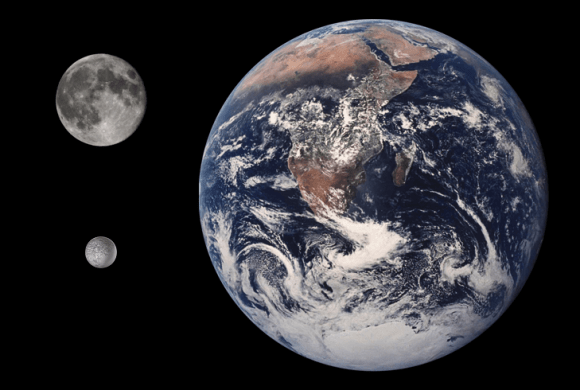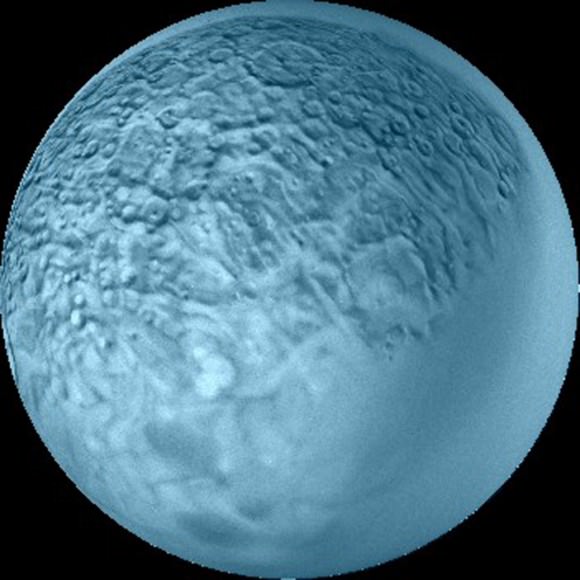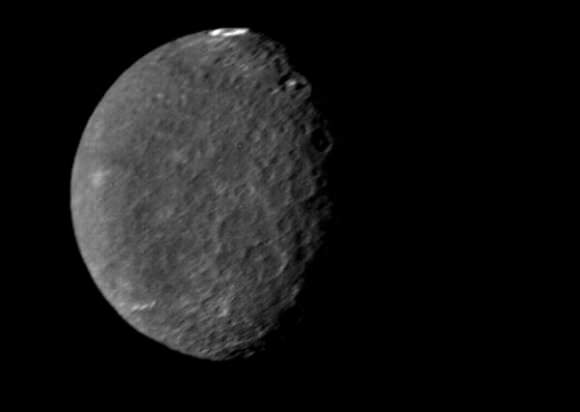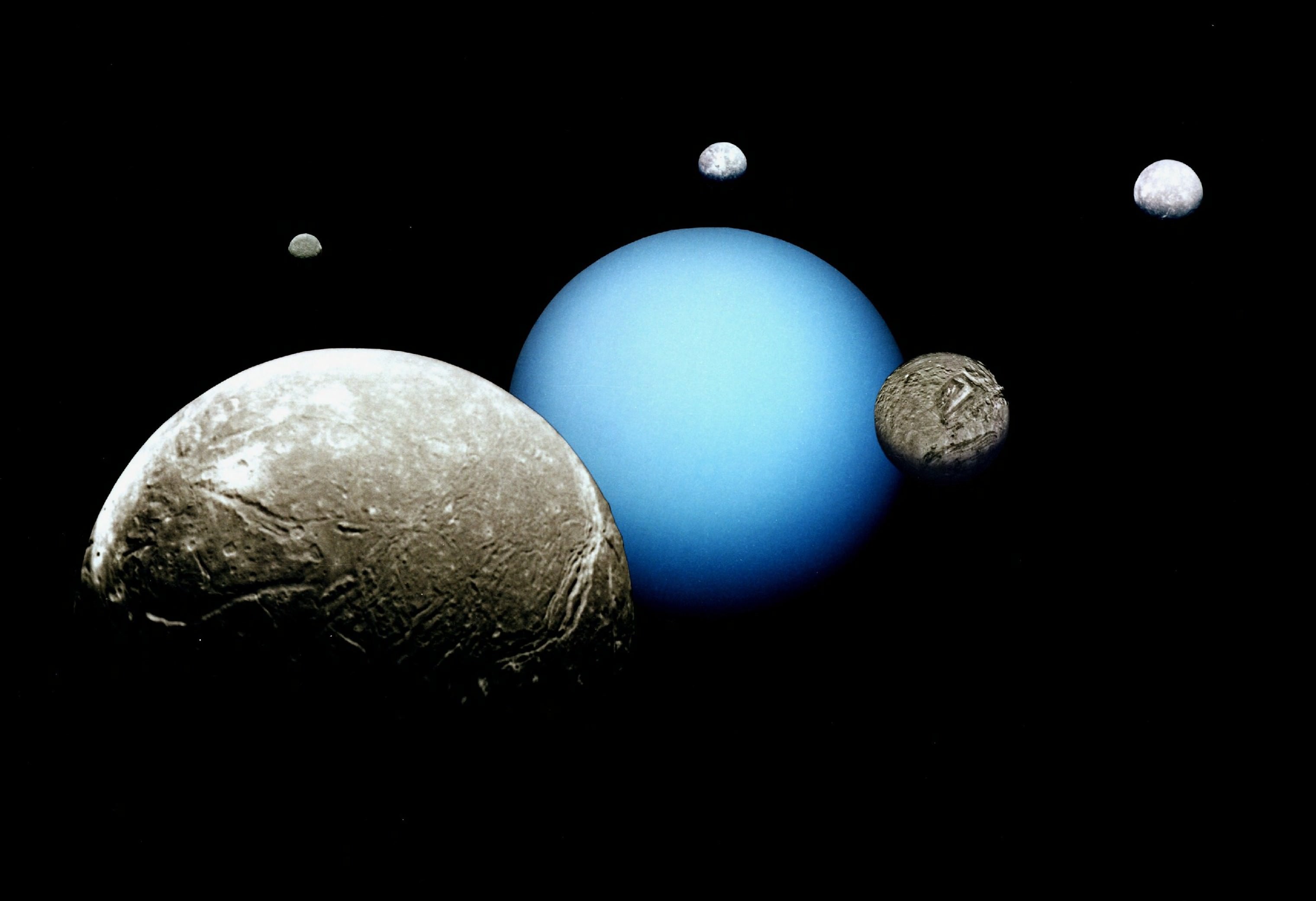The 19th century was an auspicious time for astronomers and planet hunters. In addition to the discovery of the Asteroid Belt that rests between Mars and Jupiter – as well as the many minor planets within – the outer solar planet of Uranus and its series of moons were also observed for the very first time.
Of these, Umbriel was certainly one of the most interesting finds. Aside from being Uranus’ third largest moon, it is also its darkest – a trait which contributed greatly to the selection of its name. And to this day, this large satellite of Uranus is shrouded in mystery…
Discovery and Naming:
Umbriel, along with its fellow moon Ariel, was discovered by English astronomer William Lassell on October 24th, 1851. Fellow English astronomer William Herschel, who had discovered Uranus’ moons of Titania and Oberon at the end of the 18th century, also claimed to have observed four additional moons around Uranus. However, his observations were not confirmed, leaving the confirmed discoveries of Ariel and Umbriel to Lassell, roughly half a century later.
Much like all of Uranus’ 27 moons, Umbriel was named after a character from Alexander Pope’s The Rape of the Lock, as well as plays by William Shakespeare. These names were suggested by John Herschel, the son of William Herschel, when he announced the discoveries of Titania and Oberon.

In keeping with the moon’s dark appearance, the name Umbriel – which was the name of the ‘dusky melancholy sprite’ in the The Rape of the Lock and is derived from the Latin Umbra (which means “shadow”) – seemed most appropriate for this satellite.
Size, Mass and Orbit:
Ariel and Umbriel are nearly the same size, with diameters of 1,158 kilometers and 1,170 kilometers respectively. Based on spectrograph analyses and estimates of the moon’s mass and density, astronomers believe that the majority of the planet consists of water ice, with a dense non-ice component constituting around 40% of its mass.
This could mean that Umbriel consists of an icy outer shell that surrounds a rocky core, or one made out of carbonaceous materials. It also means that though Umbriel is the third largest moon of Uranus, it is only the fourth largest in terms of mass. Furthermore, its dark appearance is believed to be the result of the interactions of surface water ice with energetic particles from Uranus’ magnetosphere.
These energetic particles would cause methane deposits (trapped in the ice as clathrate hydrate) to decompose and other organic molecules to darken, leaving behind a dark, carbon-rich residue. The satellite’s dark color is also due to its very low bond albedo – which is basically the amount of electromagnetic radiation (i.e. light) that gets reflected back from the surface.
So far, spectrographic analyses have only confirmed the existence of water and carbon dioxide. So the existence of organic particles or methane deposits in the ice remains theoretical. However, their presence would explain the prevalence of CO² and why it is concentrated mainly on the trailing hemisphere.
Umbriel’s orbital period – i.e. the time it takes the moon to orbit Uranus – is approximately 4.1 days, which is coincident with its rotational period. This means that the moon is a synchronous and tidally-locked satellite, with one face always pointing towards Uranus. The satellite is at an average distance of 266,000 kilometers from its planet, which makes it the third farthest from Uranus, behind Miranda and Ariel.
Voyager 2:
So far, the only close-up images of Umbriel have been provided by the Voyager 2 probe, which photographed the moon during its flyby of Uranus in January of 1986. During this flyby, the closest distance between Voyager 2 and Umbriel was 325,000 km (202,000 mi).
The images cover about 40% of the surface, but only 20% was photographed with the quality required for geological mapping. At the time of the flyby, the southern hemisphere of Umbriel was pointed towards the Sun – so the northern, darkened hemisphere could not be studied. At present, no future missions are planned to study the moon in greater detail.

Interesting Facts:
The surface of Umbriel has far more and larger craters than do Ariel and Titania, ranging in diameter from a few kilometers to several hundred. The largest known crater on the surface is Wokolo, which is 210 km in diameter. Wunda, a crater with a diameter of about 131 kilometers, is the most noticeable surface feature, due to the ring of bright material on its floor (which scientists think are from the impact).
Other craters include Fin, Peri, and Zlyden which, like all of Umbriel’s surface features, are named after dark sprites from different cultures’ mythology. The only satellite of Uranus to have more craters is Oberon, and the planet is believed to be geologically stable.
It is further believes that surface has probably been stable since the Late Heavy Bombardment. The only signs of ancient internal activity are canyons and dark polygons – dark patches with complex shapes measuring from tens to hundreds of kilometers across. The polygons were identified from precise photometry of Voyager 2′s images and are distributed more or less uniformly on the surface of Umbriel, trending northeast – southwest.
Because Uranus orbits the Sun almost on its side, it is subject to an extreme seasonal cycle. Both northern and southern poles spend 42 years in complete darkness, and another 42 years in continuous sunlight, with the Sun rising close to the zenith over one of the poles at each solstice.

Because they are in the planet’s equatorial plane, Uranus’ satellites also experience these changes. This means that Umbriel’s north and south poles spend 42 years in light and then 42 years in darkness before repeating the cycle. In fact, the Voyager 2 flyby coincided with the southern hemisphere’s 1986 summer solstice, when nearly the entire northern hemisphere was in darkness.
Interesting little moon isn’t it? Even though no missions are currently planned to observe it in the coming years, one can only hope that future satellites happen to sneak a peek at it on their way to some other destination in the outer Solar System.
Universe Today has many interesting articles on the moons of Uranus, like how many moons does Uranus have?
You should also check out NASA’s page on Umbriel and Uranus’ moon Umbriel at Nine Planets.
Astronomy Cast has an episode on Uranus that you should check out.
Sources:


Title is wrong. Should be Uranus.
Dernit! Thanks for the catch.
At one time, it was thought that our Gas Giants may have had a closer to the sun orbits. If this is true, any satellites they had at the time may have indeed had life at least at the molecular level. But as they moved out to the distant reaches of the solar system, life was probably extinguished.
The 19th century was actually surprisingly uneventful for astronomy. In a time when all other sciences exploded or were even founded, astronomers did little else than discover another moon or asteroid. The world view was the same in 1899 as in 1801 (post Ceres). The idea that the Sun shines because of meteors striking it was seriously proposed in the late 19th century. Still well into the 20th century Edvin Hubble didn’t get the Nobel prize because astronomy was not considered to be physics. A leftover of the 19th century view of astronomy as a branch of mathematics concerned with calculating the orbits of dots in the sky.
>> only hope that future satellites happen to sneak a peak at it
Sneak a PEEK, not “peak.”